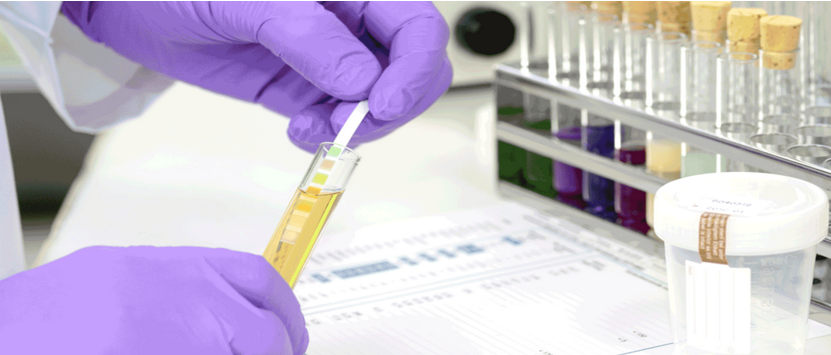

Urine drug testing is the most commonly used and widely accepted method to test for recent drugs use. It is perfect for maintaining a drug free workplace and can be used to identify a wide range of illegal and prescription drugs. It’s important to point out that while a positive urine test does not necessarily mean that an individual was under the influence of drugs at the time of the test, it has become the standard for evidence of “current use” for the U.S. Department of Labor.
There are many different situations where drug testing makes sense for your business and we offer the following services to assist you with this task:
- Pre-employment Workplace Drug Testing
- A pre-employment drug test is used to determine if a prospective hire uses illicit substances or abuses prescription medication. This is key to protecting your current employees and creating a trustworthy workforce. Pre-employment drug testing acts as an effective deterrent against drug abuse and its impact on business.
- Random Drug Testing
- If you aim to remain drug-free, random drug testing will be a vital part of your initiative. Random drug testing is a strong deterrent to drug users because it is conducted on an unannounced basis. Typically, these employees are selected by an outside third-party administrator or a computer program. Drug testing at random provides companies a powerful tool to help ensure no illegal drug use occurs in the workforce at any time.
- Annual Drug Testing
- Annual drug tests consistently remind employees that a drug-free workplace policy exists and will be enforced. These tests also help prevent any discrimination or preferential treatment. That’s because the company tests all employees annually from their date of hire. This provides a great, transparent opportunity to treat all employees equally under the company’s policies.
- Post-Accident Drug Testing
- When accidents occur on the job, it is crucial to know whether drugs were involved. While employers should not assume drugs were the cause of an accident or injury, post-accident drug tests can help determine how the issue should be handled. When accidents happen, your employees are affected mentally and physically. It’s important to show them you follow protocols and do what it takes to prevent any future incidents.
- Reasonable Suspicion Drug Testing
- Employers give reasonable suspicion drug tests when they believe an employee is under the influence of drugs when on the job. Confronting an employee about suspected drug use can be difficult, but you never want to have any regrets when it comes to the well-being of your employees.
- Return-to-Duty Drug Testing
- When an employee successfully finishes treatment for drug abuse through an EAP or the service of a substance abuse professional, return-to-duty drug tests are administered. These reassure the employer that drug use no longer poses an issue with the employee. In addition, follow-up tests may also be administered to the employee down the line to make sure the drug use does not continue at any time after treatment.
Our 13-panel test kits are able to detect Amphetamines, Barbiturates, Benzodiazepines, Opioids: Buprenorphine, Methadone, and Oxycodone, Cocaine, Ecstasy, Fentanyl, Marijuana, Methamphetamine & Tramadol
Below, we will discuss the drugs tested on a 13 panel drug test cup and the detection window in urine.
Amphetamines:
Amphetamines only stay in the urine for 48 hours. If someone were to test positive for these drugs, it means they had taken them within the past two days.
Barbiturates:
Barbiturates can stay in the urine significantly longer than some of the other drugs tested in the 13 panel test. However, the detection window ranges anywhere from 1 day to 3 weeks.
The time it stays in the urine heavily depends on the type of Barbiturate and the dosage taken.
Benzodiazepines:
Two types of Benzodiazepines are Lorazepam and Diazepam. Each of them has a different detection window with Lorazepam staying in the urine for 3 days while Diazepam can stay in the urine for 1 month.
Opioids: Buprenorphine, Methadone, and Oxycodone
Buprenorphine, methadone, and oxycodone are all types of opioids that can be tested with a 13 panel test.
Buprenorphine lasts the longest of the three in the urine, up to 6 days. Meanwhile, methadone lasts for 3 days and oxycodone can last between 2-4 days in the urine.
Cocaine:
Cocaine is difficult to spot on a 13 panel instant drug test unless someone is a continuous user. This is because cocaine only lasts 1 day in the urine.
Ecstasy:
Ecstasy, a drug similar to hallucinogens and stimulants, can be detected in the urine for up to 4 days. This drug also goes by the names MDMA and Molly.
Fentanyl:
Fentanyl is classified as a synthetic opioid used to treat severe pain when not being abused. The urine detection window for this drug is between 24-72 hours.
Marijuana:
Marijuana (THC) can last in the urine for 1-3 days. However, there is another form of marijuana, the primary metabolite THC-COOH, that lasts 5-7 days in the urine.
Methamphetamine:
Methamphetamine, more commonly known as meth, is a stimulant drug that is highly misused. Generally, meth can be detected in the urine for 1 to 4 days. However, heavy use leads meth to stay in the urine for weeks at a time.
Tramadol:
Tramadol is another synthetic opioid just as Fentanyl is. It can be detected in the urine for 1-4 days after the last use.
Contact us today to set up a consultation to discuss how we can help you